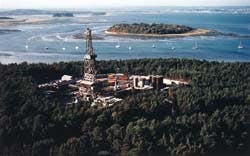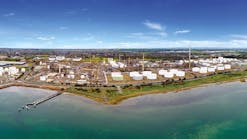David Knott
Senior Editor
Deutag Drilling is the drilling contractor for extended-reach wells in BP's Wytch Farm oil field. The Deutag rig on drill site M, used to drill the record-breaking M-11 well, is the largest in Europe, with a 3,000 hp draw works, three 1,600 hp mud pumps, and a 45,000 ft-lb top drive. Photo courtesy of BP.
- Wytch Farm Extended-Reach Drilling Radius [163,296 bytes]
- Wytch farm Extended Reach-Well Design [35,095 bytes]
The M-11 well was drilled from an onshore drill site into a reservoir that extends offshore and was brought into production on Jan. 12 at a rate of 20,000 b/d of oil.
ERD program background
BP's extended-reach drilling (ERD) program at Wytch Farm began in April 1993. M-11 is the fourteenth ERD well to have been drilled in the field, from F and M well sites on Goathorn Peninsula in Pool Harbour (see map, p. 25).The company originally intended to deplete the offshore section of the reservoir from an artificial island, but decided on ERD because it was cheaper and more environmentally benign (OGJ, Jan. 3, 1994, p. 30).
The M-11 well is the second Wytch Farm well for which BP has claimed the world extended-reach record. The earlier M-5 well set a mark of 8.035 km (OGJ, Oct. 23, 1995, p. 36).
Reservoirs
Wytch Farm is Europe's largest onshore oil field and comprises two main reservoirs plus a small, marginal accumulation.The Sherwood reservoir is a Triassic formation at a depth of 1,600 m and lies half under Poole Harbor and half extending out into the nearshore area. BP now estimates total reserves for the reservoir at 436 million bbl of oil.
The Bridport reservoir is a lower Jurassic structure at a depth of 924 m and is being depleted with conventional wells drilled from onshore drill sites. BP estimates total reserves for this reservoir at 27 million bbl of oil.
The middle Jurassic Frome reservoir lies at a depth of 800 m and has estimated reserves of 4 million bbl of oil. This is a poor-quality reservoir, partly depleted with one well.
Paul Tooms, BP manager of the ERD project, said Wytch Farm's Bridport reservoir was discovered by British Gas plc in 1974, when the field was owned 50% and operated by British Gas and owned 50% by BP.
The Sherwood formation was found in 1978, and British Gas began oil production from the Bridport formation in 1979, from temporary facilities. BP took over operatorship in 1984, when British Gas sold its interest.
Now Wytch Farm interest holders are: operator BP 50.475%, ARCO British Ltd. 17.334%, Premier Oil plc 12.381%, Clyde Petroleum (Dorset) Ltd. 7.429%, Onepm Petroleum Ltd. 7.429%, and Talisman North Sea Ltd. 4.952%.
First oil from Sherwood was produced in 1990. While the Bridport reservoir is being produced with beam pumps, all wells producing from the Sherwood reservoirs require electrical submersible pumps (ESPs).
Tooms told OGJ the Sherwood reservoir is being depleted in two stages: oil under the harbor was first produced with a number of conventional wells drilled from onshore sites.
Production from Wytch Farm is currently about 100,000 b/d of oil, of which 80% currently comes from extended-reach wells. BP's aim with further drilling is to maintain output at this plateau.
The ERD program has increased estimated original reserves from 300 million bbl for the three reservoirs before the ERD program to a combined 467 million bbl now.
"Around 1990," said Tooms, "Unocal Corp. had started to drill significant extended-reach wells off California at a similar depth. Unocal reached 4 km, and the question was raised: If they can do it, can we?
"At the end of 1991, we made the decision to go with ERD. We calculated we needed to get out to a minimum of 5 km for economic development of the reservoir, and at that time we had a dream of getting to 7 km."
As ERD technology advanced, BP grew more ambitious with its Wytch Farm drilling program, reaching a first peak with drilling of the M-5 well to more than 8 km.
"Having got M-5 so far," said Tooms, "we became aware that there was considerable oil in place beyond 8 km, from seismic data and from an appraisal well drilled offshore in 1978.
"We reckoned one pocket beyond 8 km had more than 20 million bbl of oil in place. In 1996 we began to ask what would it take to get out there. The far extent of this pocket was at 10 km."
M-11 well
In March 1996, BP decided to drill a well with a target extended reach of 10 km, to deplete the outer oil pocket, and gave itself 1 year to plan the well."The M-11 was spudded in May 1997," said Tooms. "The planning time was vital; if we'd just walked in and said we'll drill a 10 km well, I don't think we'd have achieved it."
The four main factors governing the success or failure of the well were torque, drag, directional control, and potential mud losses.
Each factor was tackled separately, although some measures taken reduced more than one.
"A well's profile is critical to torque and drag," said Tooms. "A bigger top drive was not envisaged, so we aimed to achieve smooth changes in the well bore. With previous experience of drilling extended-reach wells in Wytch Farm, we had gotten better at drilling smooth well bores."
Greg Conran, staff drilling engineer at Anadrill Schlumberger Evaluation & Production Services (U.K.) Ltd., London, said torque and drag were modeled and proved for the M-11 well ahead of drilling.
"The model predicted torque and drag from data built up in wells from M-5 onwards," said Conran. "We used data that normally would be archived. Although each earlier well had its own objectives, we worked towards M-11."
The drilling team found that friction was too high at angles of more than 82° for running casing and that the top drive could not rotate the 9-in. casing at the top of the reservoir because of pressure changes and unstable Jurassic mudstone.
"So," said Tooms, "we built on Unocal's work and floated the casing into the hole. We left the casing full of air and sealed it with flotation collars at top and bottom, filling the top with mud to take it down."
Because BP had a year to plan the well, said Tooms, they were able to try out new ideas on other wells to gain confidence for M-11. This included floating casing in earlier wells when it was not strictly required.
Directional control also was vital, because BP wanted to get most of the well bore in the reservoir within a 2 m vertical corridor. So BP helped develop a downhole-steerable drilling system.
Tooms said a conventional steerable motor requires adjustment of angles at the surface, but the M-11's requirement to cross several zones required use of a system that could be steered downhole in rotary mode.
Camco Ltd., Aberdeen, had developed a rotary steerable drilling system, which BP helped to develop further and tried it out for the first time in Wytch Farm.
Also, to help avoid damaging the hole and causing major mud losses, BP used a tool developed by Anadrill to measure downhole mud pressure while drilling.
Paddy Parsons, well-site geologist at Wytch Farm, said water production is a major headache in the field. This is being tackled by a 55,000 b/d water separation unit at the M-11 drill site.
"Water separation moved a production bottleneck away from the gathering stations," said Parsons. "Now we are trying to reduce water production by not perforating wells near faults.
"For the M-11 well, we used downhole pressure while drilling (PWD) information to keep above set permeability barriers during the drilling program."
Allan Otway, fluids manager of Baroid Ltd., Aberdeen, said various mud systems were tried in the M-11 well, but the best results were obtained with Barofibre, which contains ground almond husks.
"This mud also reduced torque by 20%, and also drag," said Otway. "We discovered this quite accidentally, when the driller noticed a reduction in torque and drag readings and asked what we were adding to the mud."
Otway added that the PWD sub-assembly showed that pipe circulation had a dramatic impact on the effective circulating density of the mud.
"By instructing the drillers not to exceed certain pressure limits," said Otway, "we could prevent surging and subsequent induction of fractures in the formation."
Problems
The M-11 hit two problems that called for sidetracks.During drilling of the 121/2-in. section of the well, the formation collapsed. Tooms said the drilling team went back to the second casing point and filled the well, then redrilled the 121/2-in. section as a sidetrack.
When this borehole had reached 9 km, BP reviewed progress and decided the well was no longer on its optimum reservoir trajectory. So the operator drilled a lateral borehole into a lower pay zone.
"We kept the upper well bore open and completed the well in the most productive zone," said Tooms. "We cased this and completed the lower lateral out to 10.1 km."
The well was completed with an ESP with capacity to produce 20,000 b/d of oil. When production began, both laterals in the M-11 were operational at the same time.
Future drilling
Tooms said an early appraisal well drilled offshore suggests one section of the Sherwood reservoir possibly extends out to 15 km.BP intends to drill a well with an extended reach of 11 km to appraise this extension.
Tooms said this well has not been given the go-ahead yet, and has the working name PZ.
"PZ is on our list of proposed wells," said Tooms. "Go-ahead depends on economic and production requirements. The only definite well on the list at the moment is M-12."
Parsons said the PZ well is likely to be drilled without a prior seismic survey, to assess the structure: "We will drill until we run out of reservoir; it will be an appraisal rather than a development well."
Parsons said the current emphasis in drilling is to provide pressure support for the reservoirs, which are mature. The M-10 well was a dual-lateral water injector: "Injection is now as much a priority as production."
Conran said Anadrill has just finished planning the M-12 well, which has an extended-reach target of 5.5 km. This is likely to be followed by a water injection well currently designated IAH but expected to become M-13.
"IAH will have a reach of 8-9 km and will most likely be drilled from the M site in mid-1998," said Conran. "There is talk of IAH being a multilateral injector."
Frank Allen, BP drilling superintendent, said the reservoir engineers want IAH to be "the mother of all injectors." He said their desire is to have a 121/2-in. pipe within the reservoir.
Because of an anticipated problem with mud weight, Allen said BP has now decided to try two 81/2-in. sections for water injection, to give even more injection capacity than first thought possible.
Other work will include intervention to recover liner in the M-2 production well, then reentry for drilling two 81/2-in. laterals into more productive zones. Drilling of M-12, IAH, M-2, and maybe PZ is expected to begin during 1998.
"M-2 could become one of our biggest producers," said Allen, "but one problem is that it has a suspected fracture at the heel of the well. We are looking into water shut-off, gels, and cement isolation here."
BP will also begin infill drilling in the western sector of the field in March, using a workover rig. Three wells with a total of seven laterals are to be drilled through midyear.
Copyright 1997 Oil & Gas Journal. All Rights Reserved.


